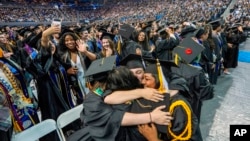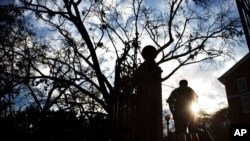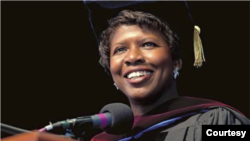Student Union
Lower-Priced Colleges Offer Options to Student Debt

This story was first reported in VOA Learning English.
As tuition and fees have increased sharply in the U.S. over the past 30 years, schools are looking for ways to make college and university more affordable.
Between 1990 and 2012 while college enrollment increased 62 percent, the volume of borrowing for school increased 352 percent, according to the Heritage Foundation. By the end of 2017, according to the Federal Reserve Bank, national student loan debt in the United States was $1.48 trillion.
One popular option is community college. These schools offer a two-year study program that awards an associate’s degree at a cost vastly less expensive than four-year schools. Those credits are typically transferrable to a four-year college or university where a student can achieve a bachelor’s degree.
Some four-year colleges and universities, often public institutions, offer free tuition but ask students to pay for room and board, like housing and food. Books and other school supplies may also be the responsibility of the students, which may add up to an unaffordable package of schools costs from some students.
Some colleges exchange part-time work on campus for lowered tuition and fees.
Berea College in rural Kentucky, does not charge tuition. The school looks for students who would otherwise struggle to pay for college.
“You have to be economically disadvantaged to get in,” Richard Cahill told VOA. He is a history professor and Director of the Center for International Education at Berea.
“We try to take the brightest of economically disadvantaged students to give them a world-class education,” he said.
The college has a history of helping people who have less since 1855. It was started by the Rev. John G. Fee, who opposed slavery. From its beginning, black and white students, male and female, studied together.
Now, there are 1,600 students, and more than 25 percent are black. 7 percent international students from over 70 countries. And "30 foreign students from 3,000 who begin their applications."
Now, there are 1,600 students. Forty percent of Berea College’s student body identifies as a person of color, according to its website and Cahill says nearly 25 percent are African-American, 10 percent are Hispanic and 7 percent international students, representing more than 70 countries.Cahill says every year the school accepts 30 of 3,000 foreign students who compete for admission online. Students work 10 to 20 hours a week on the Berea campus, to pay for room and board and books.
Other four-year colleges where international students can be part of a work program to cover all or part of their tuition include:
· College of the Ozarks — also known as “Hard Work U.” This Christian school near Branson, Missouri, admits a small number of international students. Every student works 15 hours a week, and two 40-hour work weeks a year to cover the cost of tuition.
· Warren Wilson College is a small liberal arts college near Asheville, North Carolina, with just under 700 students. Students work on campus and earn over $2,000 toward tuition. Depending on financial needs, international students may get full-tuition paid by a program called Milepost One, or other scholarships. The campus includes a 300-acre farm where students work and grow food served on campus.
· Barclay College is a smaller school with a few foreign students in rural Haviland, Kansas, a Midwest state. It is a small Christian liberal arts school with only 170 students. Director of Admissions Justin Kendall told VOA they offer free tuition to boost enrollment, and students are responsible for about $16,000 a year for room and board. Donors help make up the difference at the school. Kendall said, “they love the college, and what we’re doing here.” He says foreign students do “really, really well” there because of the small size. “They get a lot of personal attention here.”
· Curtis Institute of Music in Philadelphia offers free tuition. The school “highly values a diverse international student body,” according to its website. Musicians from 20 countries make up nearly 40 percent of the students. The school requires an audition and admits very few students.
Service academies
U.S. military academies –- also called service academies because graduates must serve in the Navy or Marines after graduation -- are technically free and even offer a stipend to students that increases as they rise in grade. The U.S. Military Academy at West Point is the oldest of the military colleges, dating back to 1802. The U.S. Naval Academy (USNA) was founded in 1845 and is known as Annapolis, in Maryland where it is located. The Coast Guard and Air Force academies are younger, established in 1930 in New London, Connecticut, and 1945 in Colorado, respectively.
But admission rates are extremely low, meaning these service academies are highly selective, requiring applicants to show not only excellent grades and test scores, but exemplary community service and recommendations from elected lawmakers.
The service academies offer slots to international students, but they are selected and sponsored by their home country governments, and be between the ages of 17 and 22 to be considered for admission. The countries are selected by the U.S. State Department and Department of Defense. West Point says American embassies ask each invited nation to nominate up to six candidates to compete for admission to the school.
West Point’s website says up to 60 international students may study at the academy at a time. The same is true for the U.S. Air Force Academy and U.S. Naval Academy. The U.S. Coast Guard Academy also admits international students.
West Point spokesman Frank DeMaro Jr. told VOA that the most recent class has students from 14 countries, including Colombia, the Gambia, Jordan, Rwanda and Thailand. After graduation, he says, they return to their countries and serve as officers in their armed forces. Graduates of U.S. service academies are expected to serve in the U.S. Army, Navy, Air Force or Coast Guard on active duty after graduation.
See all News Updates of the Day
Grace period for US student loan payments is over. Here's what you need to know

The 12-month grace period for student loan borrowers ended on September 30. The "on-ramp" period helped borrowers who are struggling to make payments avoid the risk of defaulting and hurting their credit score.
"The end of the on-ramp period means the beginning of the potentially harsh consequences for student loan borrowers who are not able to make payments," said Persis Yu, Deputy Executive Director at the Student Borrower Protection Center.
Around 43 million Americans have student loan debt, amounting to $1.5 trillion. Around eight million of those borrowers had enrolled in the SAVE plan, the newest income-driven repayment plan that extended the eligibility for borrowers to have affordable monthly student loan payments. However, this plan is currently on hold due to legal challenges.
With the on-ramp period and a separate program known as Fresh Start ending and the SAVE plan on hold, student loan borrowers who are struggling to afford their monthly payments have fewer options, added Yu. Student loan borrowers who haven't been able to afford their monthly payments must consider their options to avoid going into default.
If you have student loans, here's what you need to know.
What was the on-ramp period?
The Education Department implemented this grace period to ease the borrower's transition to make payments after a three-year payment pause during the COVID-19 pandemic. During this year-long period, borrowers were encouraged to keep making payments since interest continued to accumulate.
"Normally, loans will default if you fall about nine months behind on making payments, but during this on-ramp period, missed payments would not move people towards defaulting and then being subject to forced collections. However, if you missed payments, you still be falling behind ultimately on repaying your loans," said Abby Shaforth, director of National Consumer Law Center's Student Loan Borrower Assistance Project.
Since this grace period has ended, student loan borrowers who don't make payments will go delinquent or, if their loans are not paid for nine months, go into default.
Borrowers who cannot afford to make payments can apply for deferment or forbearance, which pause payments, though interest continues to accrue.
What happens if I don't make my payments?
Borrowers who can't or don't pay risk delinquency and eventually default. That can badly hurt your credit rating and make you ineligible for additional aid and government benefits.
If a borrower missed one month's payment, they will start receiving email notifications, said Shaforth. Once the loan hasn't been paid for three months, loan servicers notify to the credit reporting agencies that the loan is delinquent, affecting your credit history. Once the borrower hasn't paid the loan for nine months, the loan goes into default.
If you're struggling to pay, advisers first encourage you to check if you qualify for an income-driven repayment plan, which determines your payments by looking at your expenses. You can see whether you qualify by visiting the Federal Student Aid website. If you've worked for a government agency or a non-profit organization, you could also be eligible for the Public Service Loan Forgiveness Program, which forgives student debt after 10 years.
What happens when a loan goes into default?
When you fall behind on a loan by 270 days — roughly nine months — the loan appears on your credit report as being in default.
Once a loan is in default, it goes into collections. This means the government can garnish wages (without a court order) to go towards paying back the loan, intercept tax refunds, and seize portions of Social Security checks and other benefit payments.
What if I can't pay?
If your budget doesn't allow you to resume payments, it's important to know how to navigate the possibility of default and delinquency on a student loan. Both can hurt your credit rating, which would make you ineligible for additional aid.
If you're in a short-term financial bind, you may qualify for deferment or forbearance — allowing you to temporarily suspend payment.
To determine whether deferment or forbearance are good options for you, you can contact your loan servicer. One thing to note: interest still accrues during deferment or forbearance. Both can also impact potential loan forgiveness options. Depending on the conditions of your deferment or forbearance, it may make sense to continue paying the interest during the payment suspension.
What is an income-driven repayment plan?
The U.S. Education Department offers several plans for repaying federal student loans. Under the standard plan, borrowers are charged a fixed monthly amount that ensures all their debt will be repaid after 10 years. But if borrowers have difficulty paying that amount, they can enroll in one of several plans that offer lower monthly payments based on income and family size. Those are known as income-driven repayment plans.
Income-driven options have been offered for years and generally cap monthly payments at 10% of a borrower's discretionary income. If a borrower's earnings are low enough, their bill is reduced to $0. And after 20 or 25 years, any remaining debt gets erased.
What is the latest with the SAVE program?
In August, the Supreme Court kept on hold the SAVE plan, the income-driven repayment plan that would have lowered payments for millions of borrowers, while lawsuits make their way through lower courts.
Eight million borrowers who had already enrolled in the SAVE plan don't have to pay their monthly student loan bills until the court case is resolved. Debt that already had been forgiven under the plan was unaffected.
The next court hearing about this case will be held on October 15.
What happened with the Fresh Start program?
The Fresh Start program, which gave benefits to borrowers who were delinquent prior to the pandemic payment pause, also closed on September 30. During this limited program, student loan borrowers who were in default prior to the pandemic were given the opportunity to remove their loans from default, allowing them to enroll in income-driven payment plans, or apply for deferment, among other benefits.
Boston university relaunches journalism curriculum to encompass humanities

As the fall semester begins, a women’s college in Boston, Massachusetts, has retooled its media-related curriculum to best reflect the ideals of the school’s namesake, the late journalist Gwen Ifill.
Simmons University announced it would relaunch the media school as the Gwen Ifill School of Media, Humanities and Social Sciences. A search committee also named media scholar Ammina Kothari as the new dean.
The Ifill School’s new structure expands its media curriculum to include humanities and social sciences. The attributes that defined Ifill also shape a new, holistic approach, “An unwavering commitment to accuracy and objectivity, a nuanced understanding of social and historical context and a compassion-based appreciation of policymaking’s real-world implications,” according to a Simmons press release.
“Folks here are very proud of Gwen’s legacy and want to honor it in many different ways,” said Bert Ifill, Gwen’s brother and a longtime university administrator.
A crucial component of the Ifill School is its emphasis on communications, a field Gwen excelled in, Bert told VOA.
After graduating from Simmons in 1977, she had long careers in both print and television journalism, working for The Baltimore Evening Sun, The Washington Post, The New York Times, NBC and PBS. She covered seven presidential campaigns and died in 2016 at age 61.
Ifill was the first African American woman to moderate a vice presidential debate and to coanchor a national newscast, “PBS NewsHour.”
“Gwen valued storytelling, and she was an amazing journalist,” Kothari, the school’s new dean, told VOA. “But she also worked really hard to raise awareness about important social issues and to highlight underrepresented voices.”
Abigail Meyers, a current junior at the Ifill School, admires the journalist’s “groundbreaking work” in both journalism and racial justice, she told VOA. Raised near Baltimore, Maryland, Meyers feels a special connection to Ifill’s work for the Baltimore Evening Sun newspaper.
The school has been instrumental in supporting Meyers’ aspirations to become a professional journalist, she told VOA.
“The support that you get from the faculty and alumni is unlike really any other journalism program,” she said.
Being a double major in communications and political science, Meyers appreciates the new curriculum’s flexibility, as she is able to take classes across different disciplines.
This flexibility will help prime Simmons’ students to achieve success, Kothari said. She believes interdisciplinary training leads to stronger leaders in the world.
“As we think about communications or media, including journalism or social sciences, we need a strong foundation in humanities to understand the historical context for what we see happening today,” Kothari said.
The school’s increased focus on humanities “couldn’t be more timely,” according to the press release. Nearly three of four Americans believe media literacy is an important skill in today’s news landscape, a 2023 Boston University survey found.
However, humanities-focused degree programs like the Ifill School’s receive little recognition. Of all the bachelor’s degrees awarded in 2020, humanities degrees made up less than 10%, a number that has only been decreasing, according to a 2022 MIT study. Meanwhile, science, technology, engineering and math degrees, or STEM, have grown exponentially.
But humanities and STEM shouldn’t be seen as opposites, Kothari said.
She cited the COVID-19 pandemic response as an example. Many precautionary measures such as social distancing were grounded in “amazing scientific research,” but weren’t effectively communicated to the public, she said.
“As we have new knowledge being produced, we also need journalists,” Kothari said. “We need communicators who are able to translate very complex information to the audience so they can see, ‘How does it matter to me? What is the effect for me?’”
Ifill’s legacy is not only celebrated within her namesake school, but also through press freedom organizations around the world.
The Committee to Protect Journalists, a press freedom nonprofit, honors Ifill with the annual Gwen Ifill Press Freedom Award, which is presented to individuals who have “shown extraordinary and sustained achievement in the cause of press freedom,” according to CPJ’s website.
Christophe Deloire, the late director of international media freedom organization Reporters Without Borders, or RSF, received the 2024 Gwen Ifill Press Freedom Award.
“Christophe was one of journalism's greatest-ever champions,” RSF Executive Director Clayton Weimers told VOA in an email. “There was hardly a fight or an advance in press freedom in the past decade that he wasn't a part of, if not leading.”
As Ifill’s legacy spreads, there is one person who couldn’t be prouder: her brother, Bert. He told VOA it often seems as though his full-time job is “to talk nicely about Gwen.”
“It's always a great pleasure and honor for me to talk about her and to talk about her legacy, not only as obviously a very skilled journalist, but as an extraordinary mentor and confidant,” he said.
China’s youth unemployment fuels rise in postgraduate studies

Youth unemployment in China climbed to nearly 19% in August, its highest level so far this year, according to official data. Analysts say that the higher level of youth unemployment is driving more college graduates to enroll in graduate schools to escape the job search as the world’s second-largest economy struggles.
According to data released by the National Bureau of Statistics, or NBS, late last week, the unemployment rate among 16- to 24-year-olds rose from 17.1% in July to 18.8% in August. One big reason for the uptick in joblessness, the NBS said, is that nearly 12 million students graduated from Chinese universities this June, heightening competition in an already tough job market.
Postgraduates overtake graduates
“The job market has shrunk, and at the same time there are still so many graduates. Too many people are idling every day,” said Lin Chan-Hui, an assistant professor of the General Education Center at Feng Chia University in Taiwan. “Another way out is to return to school to study further and temporarily escape the competitive workplace.”
Some Chinese universities say they are seeing more postgraduate students than undergraduates.
According to the state-backed digital publication The Paper, the number of graduate students at Lanzhou University exceeded the total number of undergraduate students for the first time. Lanzhou University is located in the capital of northwestern China’s Gansu Province.
In eastern China’s coastal Zhejiang Province, the Zhejiang University of Technology shows 5,382 new graduate students were admitted this year, beating out the number of new undergraduate students by 40.
The trend was already picking up at more famous Chinese universities last year.
Last December, Beijing’s Tsinghua University said the number of undergraduate freshmen in the previous academic year was 3,760, while the number of master's and doctoral students was 12,069.
Shanghai’s Fudan University in October 2023 reported 15,000 undergraduate students and nearly 37,000 graduate students.
China's Ministry of Education said that last year there were more than 47 million people enrolled in higher education institutes, 1.3 million were graduate students, according to the official Xinhua News Agency.
Lei, a higher education consultant in Shenzhen, who due to the sensitivity of the subject only gave his surname, told VOA the trend of higher education is moving toward "college graduates who don’t go to graduate school would immediately become unemployed" amid China's economic slowdown.
"On one hand, studying in graduate school can really help you find a job. On the other hand, it’s also an avoidance mentality,” Lei said.
Wandering masters and doctors
Feng Chia University’s Lin said that having an undergraduate degree is not enough in fields like technological innovation and scientific research, so it is still necessary to get a postgraduate degree in certain fields.
On the other hand, he said, China has too many people getting doctorates and master’s degrees and not enough technical and vocational education so there will be "fierce competition for upper-level work, but no one does the lower-level work." Highly educated young people are not willing to engage in grassroots work, Lin said, so there will be more and more "wandering masters and doctors."
Lin said the geopolitical tension between China and the U.S. has also made studying abroad for a postgraduate degree harder, so more students choose a domestic one instead.
Chinese netizens seem to agree that waiting for the job market to improve is their best hope.
A Hunan netizen on China’s Weibo social media platform under the name "Da Ke Ya Tang" said: "The market will not be able to provide so many jobs in the foreseeable future, so we have to leave the problem to the future."
"If colleges and universities cannot adapt to the country's demand for innovative and pioneering talents and reform the way students are trained, more employment pressure may accumulate in society in a few years," writer Wang Guojin said in a post on Weibo.
COVID students coping?
A PhD student in Shanghai who, due to the sensitivity of the subject, only gave his surname Zeng, told VOA the increase in master's and doctoral students is also because many graduate students went to college during the COVID-19 pandemic and are struggling to adapt. Zeng blames remote learning for their struggles with social interaction and the skills needed to compete in the job market.
"This group of college students obviously lacks some socialization skills, at least in recruitment interviews,” Zeng said. “They can't reach the same level as the previous students.”
Zeng adds that monthly stipends for master's and doctoral students ranges from roughly $143 to $700 and Chinese universities encourage entrepreneurship by providing funds to start small projects through competitions.
“Who wouldn’t want to continue their studies and earn money at the same time?” she asked.
Adrianna Zhang contributed to this report.
Many US college students eligible for federal food money

Many college students in the United States are eligible for the Supplemental Nutrition Assistance Program, or SNAP, previously known as food stamps, administered by the U.S. Department of Agriculture.
But often, students don’t take advantage of the program because of complicated rules or a lack of awareness. U.S. News and World Report explains who can enroll and how to get benefits. (September 2024)
Islamic group files lawsuit against University of Georgia

The chapter of the Council on American-Islamic Relations in the U.S. state of Georgia filed a lawsuit against the University of Georgia alleging anti-Muslim discrimination.
The lawsuit says students associated with a group advocating for Palestinian justice have been the target of harassment on campus, and the university took no meaningful action to end the harassment, Atlanta News First reported. (September 2024)







